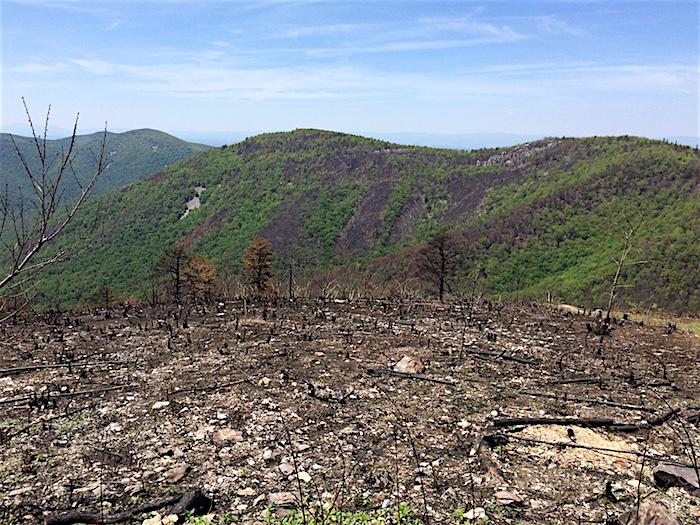
Not quite a month after the Rocky MTN fire was put out, the charred landscape of Brown Mountain from the Brown Mountain Overlook in Shenandoah National Park looked heavily damaged/NPS
American chestnut saplings reaching for the sun, mountain laurel sprouts climbing out of the soil, and sassafras rising to lend its aroma. Those are just some of the signs that more than 10,000 acres of Shenandoah National Park that burned back in the spring are coming back to life.
Unlike Western national parks, where fire season typically runs from summer into fall, in the rolling hills of the Appalachians spring and fall can bring wildfires to life. At Shenandoah in Virginia, a careless camper is thought to have ignited the Rocky MTN fire that flared up April 16 and burned across 10,326 acres before it was declared out in early May.
"There hadn't been a fire in this area in the history of the park," a period of more than 80 years, Shenandoah spokeswoman Sally Hurlbert said earlier this month during a tour of the area. "A lot of natural fuels had built up."
Normally, lightning strikes ignite low intensity fires that burn along the park's forest floor on intervals ranging from three to ten years, explained Andy Ruth, a fire ecologist-planner for the Park Service's Northeast Region. Why this area, bounded on the north by Rocky Mountain, the west by the park boundary, the south by the Big Run Portal Trail, and the east by Skyline Drive escaped those occasional burns is unknown, but the lack of flames allowed the staggering amounts of forest litter -- downed trees and thick vegetation -- to accumulate.
The resulting fire was the second largest in Shenandoah's 81-year history. Only the Shenandoah Complex Fire, which flared up in October 2000 and consisted of the Pinnacles and Old Rag blazes, claimed more acreage, 22,152 acres, according to Mr. Ruth.

Though seemingly tragic at the time, the Rocky MTN fire will have lasting benefits for the landscape it spread through/NPS
As the flames from the Rocky MTN fire moved across the mountains on the western side of Shenandoah, they fed heavily on decades of accumulated forest litter. Acres and acres of mountain laurel served as a "ladder fuel" that helped the fire creeping along the forest floor to rise up into the trees.
Before the Rocky MTN fire was doused, it had drawn roughly 350 firefighters from more than 30 states, including crews from New Mexico, to battle the flames.

By mid-September, the landscape of Shenandoah National Park that had burned under the Rocky MTN was recovering with vigor/Kurt Repanshek
While the fire forced the temporary closure of both Skyline Drive and a short section of the Appalachian National Scenic Trail in the park, the seed-rich soils, along with trees and shrubs that were burned above ground but still vital below, have quickly moved to help the landscape recover. Within four weeks after flames had been put out, areas within the fire's boundaries were showing signs of life, said Ms. Hurlburt.
Today you can see such native species as red oak, maple, aster, fireweed, black locust, poke weed, and blackberry reclaiming the forest floor. However, there also are invasives, such as ailanthus (tree of heaven).
Long-term, the lasting calling card of the Rocky MTN fire likely will be a rich and robust understory. After the Shenandoah Complex Fire in 2000, park researchers documented that while the flames killed the "above-ground portions of most saplings and shrubs...ultimately (they) stimulate understory growth."
Also returning to the landscape are black bears. Park officials, interpolating from Shenandoah's overall bear density, estimate that 15-20 bears were displaced by the fire. Those bruins have been moving back into the area, evidenced by logs that were pulled apart and turned over by bears hoping to make a meal out of insects.
While Shenandoah officials wouldn't have used a prescribed fire last April to achieve the resulting benefits seen today because of the extremely dry and dangerous fire conditions at the time, they realized benefits would follow the flames.
"Having not burned for over 85 years, (in an area where low intensity ground fires should naturally occur every 3-9 years) the Rocky Mount area of the park has had an unnaturally high level of fuel accumulation (leaves, pine needle litter, branches and fallen trees) and was destined to burn at some point," Superintendent Jim Northup said at the time in an open letter to the surrounding communities worried about the fire.
"As a result of the fire, organic material and other nutrients have been recycled into the soil, which will stimulate new plant growth. Burning primarily leaves and dead and down material, the fire will result in very little tree mortality, and very little negative impact on wildlife species, which have evolved in the presence of fire over thousands of years. The fire will be particularly beneficial for several plant species including native grasses and wildflowers, oak and pine communities. Wildlife, including white-tailed deer, black bear, songbirds and many other species will benefit from the acorns, blueberries and other seeds, produced by plants rejuvenated by fire."
Wherever you look in the landscape burned by the Rocky MTN fire, rebirth is visible. It's an open book of fire ecology. Walk into the landscape, and you'll come to appreciate both the power, and the benefits, of wildfire.


 Support Essential Coverage of Essential Places
Support Essential Coverage of Essential Places







Comments
Fantastic story of rebirth in Shenandoah!
Do eastern hemlocks typically show regeneration after a fire?